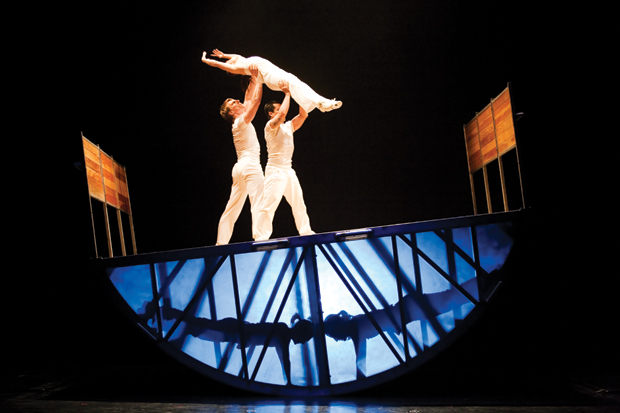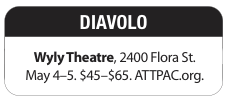Jacques Heim, founder and artistic director of the fanciful dance troupe Diavolo, creates poetry from motion

FIRST MOVEMENT | Jacques Heim, inset, pushes the boundaries of dance with Diavolo, mixing the human form and technology.
STEVEN LINDSEY | Contributing Writer
stevencraiglindsey@me.com
When Jacques Heim founded Diavolo Dance Theater in 1992, he probably wasn’t expecting it to become an officially recognized cultural treasure by the city of Los Angeles. And now, for two performances only, Dallas gets to discover this legendary jewel in all its brilliance.
Diavolo deftly combines a company of dancers, gymnasts, athletes and actors to form a team that has a reputation for putting on elaborate shows that transcend the simple notion of what modern dance is all about. The Dallas show is entitled Fearful Symmetries, the second installment of a trilogy commissioned by the Los Angeles Philharmonic. It premiered in 2010 and features music by John Adams.
 “Fluid Infinities is an abstract piece that starts as a cube. This cube can represent the answers to where do we come from? and where are we going? It can represent a super-power, religion, anything the audience wants to see it as,” says Heim. “The dancers are dressed like abstract factory workers who deconstruct, reconstruct and alter the cube to create new environments and try to understand what it is all about. Eventually they realize the answer doesn’t lie with the cube, but within themselves. The audience really will interpret what it means to them individually.”
“Fluid Infinities is an abstract piece that starts as a cube. This cube can represent the answers to where do we come from? and where are we going? It can represent a super-power, religion, anything the audience wants to see it as,” says Heim. “The dancers are dressed like abstract factory workers who deconstruct, reconstruct and alter the cube to create new environments and try to understand what it is all about. Eventually they realize the answer doesn’t lie with the cube, but within themselves. The audience really will interpret what it means to them individually.”
Perhaps the most important aspect of the show is that, according to Heim, you don’t even have to understand it to appreciate it. Regardless of deeper context, the show is so visually stunning that audiences can’t help but be mesmerized.
“There’s a little something for everyone, it’s not just dance,” he says.
Yet Diavolo is somehow greater than each of the individual shows that make up its repertoire. It’s a place for artistic growth, and seeing the progression of each performer is something that has inspired Heim for 20 years.
“I want to continue to experience that relationship with them and their journeys. If I am to dream for the future, I would like to see us open a training school where we could encourage and develop so many more dancers for a life in the arts.”
Heim, who once choreographed the show KA for Cirque du Soleil, says the creative process for staging Cirque shows and Diavolo shows is the same with but one major difference.
“The show KA is like Diavolo on steroids,” he says of Cirque’s “unlimited budget.”
Though that doesn’t mean to expect anything short of stunning in Fearful Symmetries.
“There are so many elements to coordinate with scheduling, rehearsing, design, building, timing and, of course, costs are always a huge factor to consider and try to control. The bigger the event, the more cooks there are in the kitchen, so it’s a huge amount of pressure to get it all right,” Heim explains.
And from the reaction of audiences worldwide and the company’s continued growth and prosperity, he gets it right every time. Even behind the scenes, Diavolo is an ever-evolving entity, becoming more diverse as the years progress.
“When we first started the company was entirely straight, and it was chaotic! Bringing in some gay members actually evened it out and helped to create a balance within the group,” he says. “We have a mix of real and unique artists in our company and that includes gay, straight, white, black, Asian — you name it, we represent it.”
Heim offers up one final bit of advice to anyone reading this story.
“You can’t just read about Diavolo. The only way to understand it is to experience it,” he says excitedly. “You have to be there!”
This article appeared in the Dallas Voice print edition May 4, 2012.
